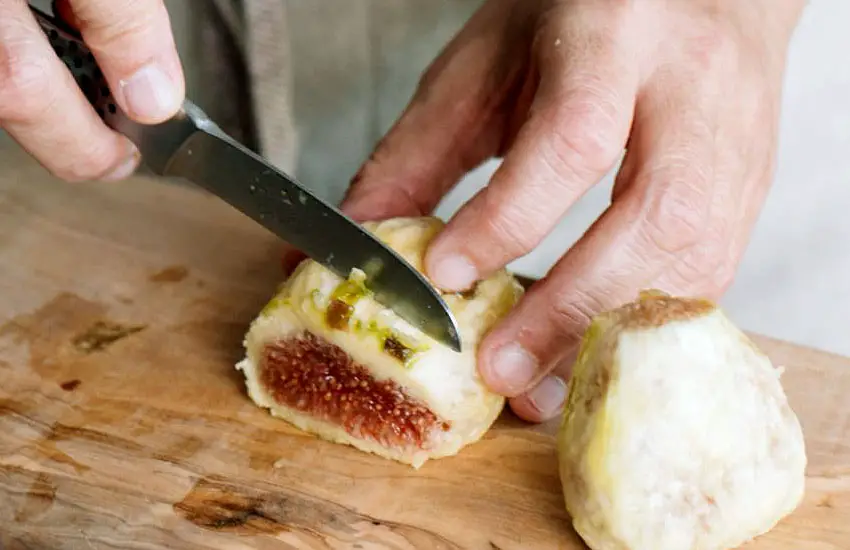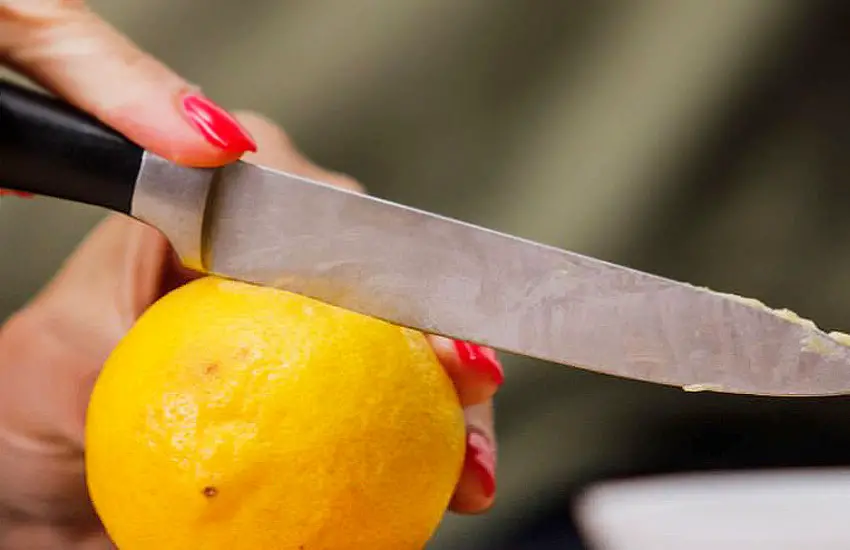As an Amazon Associate, I earn from qualifying purchases at no extra cost to you.
Easy Way to Use Paring Knife Like a Pro: Simple Technics
If you’ve ever struggled with getting the most out of this handy kitchen tool, fear not – we’re here to help. A paring knife may be small, but it’s mighty in its capabilities for slicing, dicing, and precise cutting. In this article, we’ll break down the basics into simple steps, making it easy for anyone to master.
From understanding the right grip and stance to ensuring safety while slicing, we’ve got you covered. Whether you’re a beginner cook looking to enhance your kitchen skills or a seasoned chef aiming for greater precision, this guide will equip you with the knowledge and techniques needed to wield a paring knife like a pro. Let’s dive in and unlock the full potential of this essential kitchen tool!

Grip and Stance
When you’re using a paring knife, how you hold it and stand is very important. This is called your grip and stance.
Getting a Comfortable Grip
To start, hold the paring knife firmly but comfortably in your dominant hand. You want a grip that feels secure but not too tight, allowing for flexibility and control as you work.
Positioning Yourself Correctly
Next, adopt a stable stance by standing with your feet shoulder-width apart. This position provides a solid foundation, helping you maintain balance and control while using the knife.
Holding the Food Securely
As you prepare to use the paring knife, it’s important to hold the food item securely with your non-dominant hand. Curl your fingers slightly inward to create a protective barrier between the blade and your fingertips. This “claw grip” keeps your hand safe while also providing stability for the food as you cut.
Balancing the Knife
When gripping the knife, find a balance between firmness and flexibility. You want enough pressure to maintain control over the blade, but not so much that it becomes difficult to maneuver. Experiment with your grip until you find a comfortable balance that works for you.
Using a Controlled Motion
As you make cuts with the paring knife, employ a controlled motion to guide the blade through the food. Instead of relying solely on force, focus on using a smooth, fluid motion that allows the knife to do the work for you. This technique helps prevent accidents and ensures more precise cuts.
Practicing Patience and Precision
Finally, remember to take your time and work with precision. Rushing through cuts can lead to mistakes and accidents. Instead, focus on maintaining a steady pace and paying attention to the task at hand. With practice, you’ll develop the skills needed to use the paring knife with confidence and precision.
Technique for Precision

Rocking Motion
One key technique for using a paring knife with precision is the rocking motion. Instead of chopping straight down, tilt the knife slightly and use a gentle rocking motion. This allows the tip of the knife to act as a pivot point, making it easier to control the depth and angle of your cuts.
Short, Deliberate Strokes
When using a paring knife, it’s important to use short, deliberate strokes. Avoid applying excessive force, as this can lead to uneven cuts or even slipping of the blade. Instead, focus on making controlled movements, letting the sharpness of the knife do the work for you.
Consistent Pressure
Maintaining consistent pressure on the blade is essential for achieving even and smooth cuts. Whether you’re slicing through soft fruits or finely dicing vegetables, strive to apply the same amount of pressure with each stroke. This helps ensure uniformity in your cuts and prevents the knife from veering off course.
Angle of the Blade
Pay attention to the angle of the blade as you cut. Depending on the task at hand, you may need to adjust the angle of the knife to achieve the desired result. For example, when peeling fruits or vegetables, a shallow angle can help remove the skin more efficiently.
Practice Makes Perfect
Like any skill, mastering the technique for precision with a paring knife takes practice. Take the time to experiment with different cutting techniques and find what works best for you. With patience and persistence, you’ll soon develop the confidence and dexterity needed to use a paring knife with precision in your culinary adventures.
Safety Measures
Use a Cutting Board
Always use a cutting board when using a paring knife. This protects your countertops and prevents the knife from slipping, reducing the risk of accidents.
Keep Fingers Tucked Away
When holding the food item, keep your fingers tucked safely away from the blade. Use a “claw grip” by curling your fingertips under and using your knuckles to guide the knife. This helps prevent accidental cuts.
Mind the Direction
Avoid cutting towards yourself. Instead, work in a direction away from your body. This reduces the risk of injury if the knife slips or if you lose control while cutting.
Store Safely
When not in use, store your paring knife safely. Keep it in a knife block or sheath to protect the blade and prevent accidents when reaching into drawers or cabinets.
Clean Immediately
After using the knife, wash it by hand with mild soap and warm water. Dry it thoroughly before storing to prevent rust and corrosion.
Handle with Care
Handle the knife with care, both during use and when storing. Avoid dropping it or leaving it in areas where it could be knocked over. By treating your paring knife with care, you’ll prolong its lifespan and reduce the risk of accidents.
Cleaning and Maintenance
Hand Wash with Mild Soap
After using your paring knife, it’s important to wash it by hand with mild soap and warm water. This helps remove any food residue and bacteria, keeping the knife clean and safe to use for your next culinary adventure.
Use a Soft Sponge or Cloth
When washing your paring knife, use a soft sponge or cloth to avoid scratching the blade. Gently scrub the blade and handle to remove any stuck-on food particles. Avoid using abrasive scrubbers or steel wool, as these can damage the knife’s surface.
Dry Thoroughly
After washing, be sure to dry your paring knife thoroughly with a clean towel. Moisture can cause rust and corrosion, so it’s important to remove all excess water before storing the knife.
Store Properly
To protect the blade and prevent accidents, store your paring knife properly when it’s not in use. Consider using a knife block or magnetic strip to keep the blade safely stored and easily accessible. Avoid storing knives loose in drawers, as this can lead to damage and accidents when reaching for other items.
Sharpen Regularly
To maintain optimal performance, it’s important to sharpen your paring knife regularly. You can use a sharpening stone, honing rod, or electric knife sharpener to keep the blade sharp and ready for use. Be sure to follow the manufacturer’s instructions and guidelines for sharpening your specific knife model.
Oil the Blade
Applying a thin layer of oil to the blade can help protect it from rust and corrosion. After cleaning and drying your paring knife, lightly coat the blade with a food-safe oil, such as mineral oil or vegetable oil. Use a clean cloth to apply the oil evenly, then wipe off any excess before storing the knife.
Check for Damage
Regularly inspect your paring knife for any signs of damage, such as chips or cracks in the blade. If you notice any issues, it’s important to address them promptly to prevent further damage and ensure the safety of your knife. Depending on the severity of the damage, you may need to have the knife professionally repaired or replaced.
Handle with Care
Handle your paring knife with care to prolong its lifespan and maintain its performance. Avoid dropping the knife or using it to pry open containers, as this can cause damage to the blade and handle. Instead, use the knife only for its intended purpose – cutting and slicing food items.
By following these simple cleaning and maintenance tips, you can keep your paring knife in top condition for years to come. Remember to wash and dry the knife after each use, store it properly, sharpen it regularly, and handle it with care. With a little TLC, your paring knife will continue to serve you well in all your culinary endeavors.
Conclusion
A paring knife is a versatile tool that can assist in a variety of kitchen tasks. With proper techniques and care, you can confidently use a paring knife to peel, trim, and create intricate designs. Understanding the correct grip and maintenance will ensure your paring knife remains a valuable asset in your kitchen arsenal.
Happy cooking!
